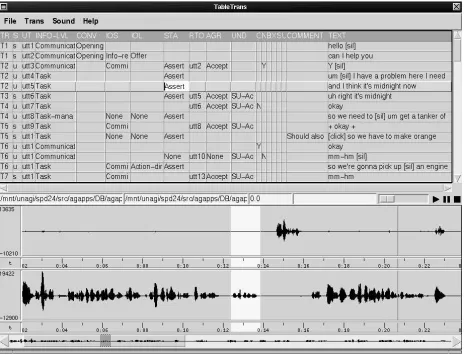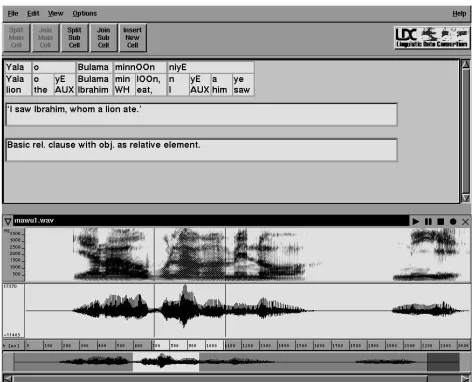Figure 1: TableTrans With WaveSurfer
4.
TableTrans
TableTrans is a spreadsheet-based annotation tool for audio signals. It was primarily intended for linguistic anno-tations, but it can be used for many kinds of observational coding, such as widely practiced in ethology. The tool al-lows users to annotate regions of signal with arbitrary fea-tures, such as speaker identifiers, utterance identifiers and transcriptions. Each row of the spreadsheet corresponds to a region of the signal. Each column corresponds to a user-defined feature, and has a user-user-defined width. For example, one could define the width of 5 characters for the speaker identifier, and the width of 40 for the transcription. One could also choose to define ten or more columns as shown below, and use it for more structured coding.
Figure 1 shows TableTrans with a waveform display based on WaveSurfer. Figure 2 shows TableTrans with a video module based on QuickTime and QuickTimeTcl.
Setting Current Region Swiping a region in the wave-form display while holding down the left-mouse button highlights the region. This region is called the current re-gion. In the video version of TableTrans, the current region can be set with two operations: pressing control-s at the be-ginning of the region, and pressing control-e at the end of the region.
Create Annotation Pressing the Return key inserts a blank annotation row in the spreadsheet. If the current re-gion of the waveform is chosen, the start and end times of the current region are inserted.
Delete Current Annotation Pressing Control-d deletes the currently highlighted annotation (the current annota-tion).
Update Current Region Pressing Control-g updates the start and end times of the current annotation using the cur-rent region in the waveform.
Navigate in Spreadsheet The Tab key moves the cursor one cell to the right, if possible. The right, left, up, and down arrows move to the neighboring cells in the corre-sponding directions.
Navigate Within Current Cell The Shift-Right and Shift-Left keys move the insertion point within the current cell.
Figure 4: MultiTrans, for Transcribing Multi-Party Conversation
B: This is the second annotation for speaker 2. It is also the current annotation, and is highlighted.
C: A segment for speaker 1. This shows some of the tran-script for this annotation and the associated region of the waveform.
D: The highlighted region of the waveform for the second annotation. This is the current annotation and its entire waveform region is highlighted.
E: The hollow play button. This button will play the cur-rent channel only, muting other speech channels.
There are two ways to create an annotation, both are explained below. All annotations are inserted into the text panel, sorted by their starting position.
Create Annotation (Specific) The first way to create an annotation is to explicitly highlight a region in the wave-form and press the Return key. This will create a bullet in the appropriate text panel that designates the created anno-tation. Also, a region is created below the waveform itself to designate the created annotation. Only once an annota-tion is created can the transcripannota-tion of that region begin.
Create Annotation (Non-Specific) Another way to cre-ate an annotation is during speech playback. When the playback of speech is begun the user may press the Return key to insert an anchor in the current channel. When Return is pressed a small black bar will appear below the wave-form. This designates the starting position of the current annotation. When Return is pressed a second time the end anchor for the annotation is inserted and the annotation is created. Ending speech playback destroys any start anchors that do not yet have an associated end anchor.
Delete Current Annotation An annotation can be deleted using Control-d. To delete an annotation one must first select the annotation to be deleted. The current anno-tation can easily be distinguished from others because its transcription and waveform regions are highlighted. When an annotation is deleted its transcription and its association with the waveform region are also deleted.
Figure 6: TreeTrans: Syntactic Transcription (Horizontal and Vertical Views)
7.
TreeTrans
TreeTrans is a tool for displaying and annotating tree structures.2 Basic annotation functions are provided, and
functions can be easily added or changed for specific an-notation projects. Trees can be displayed in three forms: bottom-up, top-down, and vertical. Two views of trees in TreeTrans are shown in Figure 6. Every node of the dis-played tree has one of three types: syn, a syntactic or in-ternal node; pos, a part-of-speech node; orwrd, a node containing original text.
To change a displayed tree, users highlight the appropri-ate node(s) then choose a function from the list of buttons. All the tree manipulation functions preserve the surface or-der of the word string.
Input/Output TreeTrans can input either Penn Treebank-style bracketed trees or annotation graphs. Likewise, it can store annotated trees in either of these formats.
InsertInternalNode If one node is highlighted, this func-tion adds an internal node as the parent of the highlighted node. If two nodes are highlighted, this function adds an internal node as the parent of the the two highlighted nodes and any intervening material. If the branches of the new internal node would cross any existing branches of the tree, the insertion is not performed.
Delete This deletes the highlighted node. If the high-lighted node has typepos, its correspondingwrdnode is also deleted. If the deletion would cause an internal node to have no leaves, the deletion is not performed.
2For a discussion of how to model trees using annotation
graphs, see (Bird and Liberman, 2001; Cotton and Bird, 2002).
MoveNode When two nodes are highlighted, this moves the first highlighted node and its subtree to become a child of the second highlighted node. When three nodes are high-lighted, the first two nodes and any intervening material are moved to become children of the third highlighted node. The move is not performed if it would cause word order to be changed, or if it would result in an internal node with no leaves.
Adjoin This is a syntactic adjoin, which creates a clone of the second highlighted node, then moves the first high-lighted node to become a child of the clone.
SynWrdBefore/After This function adds a pair of nodes, one of typesyn, and one of typewrd. It is used for adding traces to the text. The newsynnode is a previous or fol-lowing sibling of the highlighted node.
ChangeLabel This changes the label of the highlighted node.
CoRef This gives two highlighted nodes the same trace number.
BuildDefaultTree This builds a basic tree structure using the input sentence as the terminals of the tree.
8.
Obtaining the tools
All of the annotation tools described in this paper are distributed under an open source license, and available from [http://www.ldc.upenn.edu/AG/].
9.
References
S. Bird and M. Liberman. 2001. A formal framework for linguistic annotation. Speech Communication, 33:23– 60.
S. Cotton and S. Bird. 2002. An integrated framework for treebanks and multilayer annotations. In Proceedings of the Third International Conference on Language Re-sources and Evaluation.
R. Grishman. 1997. TIPSTER Architecture Design Document Version 2.3. Technical report, DARPA.
http://www.nist.gov/itl/div894/894.
02/related_projects/tipster/.
X. Ma, H. Lee, S. Bird, and K. Maeda. 2002. Models and tools for collaborative annotation. In Proceedings of the Third International Conference on Language Resources and Evaluation.
K. Maeda and S. Bird. 2000. A formal framework for inter-linear text. In S. Bird and G. Simons, editors, Proceed-ings of the Workshop on Web-Based Language Documen-tation and Description. http://www.ldc.upenn.
edu/exploration/expl2000/papers/.
K. Maeda, S. Bird, X. Ma, and H. Lee. 2002. Creating an-notation tools with the anan-notation graph toolkit. In Pro-ceedings of the Third International Conference on Lan-guage Resources and Evaluation.
K. Sj¨olander and J. Beskow. 2000. WaveSurfer – an open source speech tool. In Proceedings of the 6th Inter-national Conference on Spoken Language Processing.




